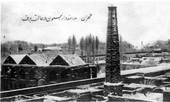Organization:Dar ul-Funun (Persia)
دارالفنون | |
 Eastern gate of Dar ul-Funun in the Naser Khosrow Street. The motto is inscribed on the upper part of the front face. | |
| Motto | |
|---|---|
Motto in English | Mighty is he who has knowledge By knowledge the old hearts grow young again (couplet from Ferdowsi's Shahnameh)[2] |
| Type | Polytechnic |
| Established | 1851 |
| Endowment | 7,750 tomans (initially) 30,000 tomans (in 1930) |
| Location | , |
| Language | Persian |
Dar ul-Funun (Persian: دارالفنون Persian pronunciation: [dɒːɾolfʊˈnuːn], meaning "Polytechnic"), established in 1851, was the first modern university and modern institution of higher learning in Iran (Persia).
Introduction
Founded by Amir Kabir, then the royal vizier to Nasereddin Shah, the Shah of Persia, Dar al-Funun originally was conceived as a polytechnic to train upper-class Persian youth in medicine, engineering, military science, and geology. It was similar in scope and purpose to American land grant colleges like Purdue and Texas A&M. Like them, it developed and expanded its mission over the next hundred years, eventually becoming the University of Tehran.[3]

The institute was planned by the Iranian educated Mirza Reza Mohandes, and built by the architect Muhammad Taqi Khan Memar-Bashi under the supervision of the Qajar prince Bahram Mirza. Facilities such as an assembly hall, a theater, library, cafeteria, and a publishing house were built for the institute. In 1930, the building was destroyed by Mirza Yahya Khan Qaragozlu (also known as Etemad-od-Dowleh), then Minister of Education, and rebuilt based on a Russian engineering design.
Many parts of the institute were later on absorbed and merged into the newly establishing Tehran University. The Faculty of Medicine for example, was particularly the successor to the Dar ul-Funun Department of Medicine, established in 1851, which had become the School of Medicine (Madreseh-ye tebb) in 1919.[4]
The elite school was training 287 students by 1889, and had graduated 1100 students by 1891. During this time, the faculty consisted of 16 European, and 26 Iranian professors.
Notable alumni
- Mirzā Mehdi Khān Shaqāqi (Momtahen-od-Dowleh) (1808–1882), architect
- Ali-Qoli Khān Hedāyat (Mokhber-od-Dowleh) (1829–1897), politician
- Mohammad-Hassan Khān (Sanee-od-Dowleh) (1843–1896), politician
- Mírzá Abu'l-Faḍl-i-Gulpáygání (1844–1914), Baha'i scholar
- Abdolmajid Mirza (Eyn-od-Dowleh) (1845–1927), prime minister
- Mirza Ali-Akbar Khān (Nazem-ol-Atebba) (1847–1924), physician
- Mohammad Khān Ghaffari (Kamal-ol-Molk) (1847–1940), painter
- Morteza-Qoli Khān Hedāyat (Sanee-od-Dowleh) (1856–1911), politician
- Mahmoud Khān Alamir (Ehtesham-os-Saltaneh) (1862-?), politician and diplomat
- Ebrahim Hakimi (1863–1959), prime minister
- Mohammad Mirza (Kashef-os-Saltaneh) (1865–1929),[5] diplomat and entrepreneur
- Ali-Akbar Dāvar (1885/88–1937), minister of Justice
- Gholam-Hossein Darvish (1872–1926), musician
- Jahangir-Khan Sur-e-Esrafil (1874–1908), journalist and political activist
- Mohammad-Ali Foroughi (Zoka-ol-Molk) (1877–1942), prime minister and scholar
- Ali-Akbar Dehkhodā (1879–1956), politician, author and linguist
- Hossein Khan Motamed (1893–1955), surgeon
- Hossein Gol-e-Golab (1895–1985), musician
- Ali-Akbar Siassi (1895–1990), scholar
- Haj Ali Razmara (1901–1951), Imperial Iranian Army (IIA) general and prime minister
- Sadeq Hedayat (1903–1951), novelist
- Mojtaba Minovi (1903–1976), scholar and historian
- Ali Amini (1905–1992), prime minister (1961-62)
- Mohsen Hashtroodi (1908–1976), scholar and mathematician
- Mohammad Gharib (1909–1975), physician
- Manouchehr Eghbal (1909–1977), prime minister (1957-60)

- Mohammad Moin (1914–1971), scholar and linguist
- Fereydun Adamiyat (1920–2008), historian and diplomat
- Jalal Al-e Ahmad (1923–1969), author and political critic
- Fereydoon Moshiri (1926–2000), poet
- Ehsan Naraghi (1926–2012), sociologist and writer
- Mostafa Chamran (1932–1981), minister of National Defence
- Faramarz Payvar (1933–2009), musician
- Siavash Kasrai (1927-1996), poet
- Dariush Ashoori (1938- ), author and translator
- Bahram Bayzai (1938- ), film director
- Ahmadreza Ahmadi (1940- ), poet and screen writer
- Mohammad-Ali Sepanlou (1940- ), poet
- Mohammad-Hossein Adeli (1953- ), politician and economist
- Majid Ghassemi (1952- ), banker and economist
See also
- Higher education in Iran
- Alborz High School
- Academy of Gundishapur
- Nizamiyyah
- List of universities in Iran
- List of Iranian scientists from the pre-modern era.
- Modern Iranian scientists and engineers
- List of Iranian Research Centers
- School of Nisibis
- Sarouyeh
- Baku State University (Baku State Dar ul-Funun)
- Istanbul University (Dar ul-Funun in Turkey)
References and notes
- ↑ Transliteration: Tavānā bovad har keh dānā bovad – Ze dānesh del-e pīr bornā bovad
- ↑ In verse form the couplet may be translated as: Capable is he who is wise – Happiness from wisdom will arise.
- ↑ For an illustrated report on Dar ol-Fonoun see: Hamid-Reza Hosseini, Dar ol-Fonoun in want of love ("Dar ol-Fonoun dar hasrat-e eshgh"), in Persian, Jadid Online, September 22, 2008, [1]. The pertinent photographs (15 in total) can be viewed here: [2].
- ↑ Encyclopædia Iranica: http://www.iranicaonline.org/articles/faculties-v
- ↑ See Mohammad Mirzā Kāshef-os-Saltaneh in Persian Wikipedia.
External links
[ ⚑ ] 35°41′1.64″N 51°25′18.71″E / 35.6837889°N 51.4218639°E

